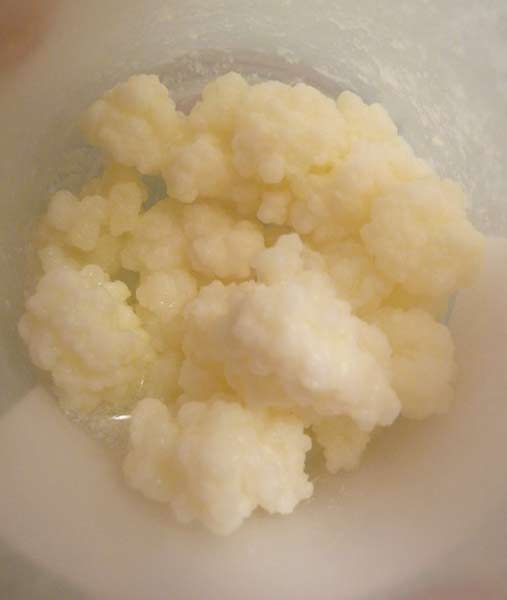
Low-fat plain Kefir has many benefits. It's probiotic, which means that it's filled with 'good' bacteria, also known as 'live cultures' that can help relieve digestive problems.
Kefir is also a high-protein, low fat food, maintaining a healthy diet.

Kefir is a thick, microbial-rich cultured milk that can be extremely beneficial in re-balancing inner body ecology.
It is a tart yogurt-like fermented food that contains friendly bacteria and yeasts that work together to provide natural probiotic properties.
It has a long history, originating in the Caucasus mountain regions, between Turkey and Russia, where it was revered as a sacred food.
Turkish meaning "to feel good."
"Kefir has tremendous healing power. With its laxative effect it helps clean the colon. Its beneficial bacteria and yeast help control the pathogenic yeast and repopulate the colon with a favorable, new life force."
Kefir is traditionally made from cow or goat milk but, as an alternative to dairy, it can also be made with coconut meat/water or nut milk blends.

Benefits of Kefir Yogurt Drink
It is one of the best superfood drinks for re-establishing friendly flora in the intestinal tract. This "medicinal drink" coats the stomach lining and contains tryptophan, an amino acid that works with calcium and magnesium to relax the nerves.The body converts tryptophan into serotonin, an important chemical called a neurotransmitter; balanced serotonin levels can cure depression and constipation, induce sleep and prohibit waking during the night."
Kefir is, of course, great for anyone with candida and is often a necessary addition to the diet for complete colon health and restoration of the digestive tract.
Nutritional Value:
- acts as a natural probiotic
- balances inner body ecology
- provides high quality enzymes
- supplies B vitamins and amino acids
- helps with proper digestion of foods
- a source of good fats
- contains an abundance of calcium and magnesium
- gives essential friendly flora, like lactobacillus
- builds the immune system
 |
As it ferments, it develops a complex matrix of many different micro-organisms than can greatly improve the health of the colon.
The "tara" grains of the Tibetan peoples are a cousin to this cultured grain, which has provided them with a similar fermented drink for eons.
As legends tell, "kee-fir" grains are said to have been passed down by Allah and delivered to the prophet Mohammed, who held them in his possession, sharing only with family.
But one day, it mistakenly ended up in the hands of a Russian acquaintance who then took it back to her country as a cherished drink that still exists today throughout that region.
The grain starter is made up of a polysaccharide known as kefiran, which reproduces itself during the process of fermentation. This allows for a continuous supply of grains, much like that of the kombucha mushroom and koji (used to ferment miso). Kefiran has also been shown to decrease blood pressure and cholesterol levels.
Milk Kefir Grains
These grain cultures produce a thick liquid, yogurt-like drink that is traditionally made from dairy milk, but as we mentioned can also be made from nuts, seeds and coconut meat/water.If you do make kefir from milk, we suggest using raw cow or goats milk. To make this type of kefir, however, you will need to heat it initially to 92 degrees as there are enzymes in the "raw" dairy that may compete with the kefir culture.
Water Kefir Grains
These grains can be used with sugar water, juice or coconut water. Many people are now into making simple water kefirs that do not involve dairy or heavier nut based milks. These are most ideal for those with candida who wish to reduce the amount of these foods in their diet.Water kefir is made in the same way that you make milk kefirs and requires the same amount of time to ferment.
It is easy to make at home right on your kitchen counter. It is a simple 10-24 hour process that ferments the lactose content into a sour, tangy beverage.
Traditionally "kee-fir" is made with dairy milk, as we mentioned, but we like to use raw vegan substitutes that work just as well.
Quite often this fermented drink is combined with fruit and sweeteners (like yogurt) to make a sweet, tasty thick drink.
We like to add some of the top 10 superfoods, like bee pollen and goji berries, maybe a little blue green algae, along with any of the natural sweeteners, like stevia or raw honey.
Using Kefir Grains or Starter
You don't necessarily need to use kefir grain culture because you can also buy starter packets that come in powdered form.We personally prefer the whole grains as opposed to the powder. We like to watch them grow and proliferate, knowing you can keep using them over and over again!
wellness/natural-medicine/herbal-remedies